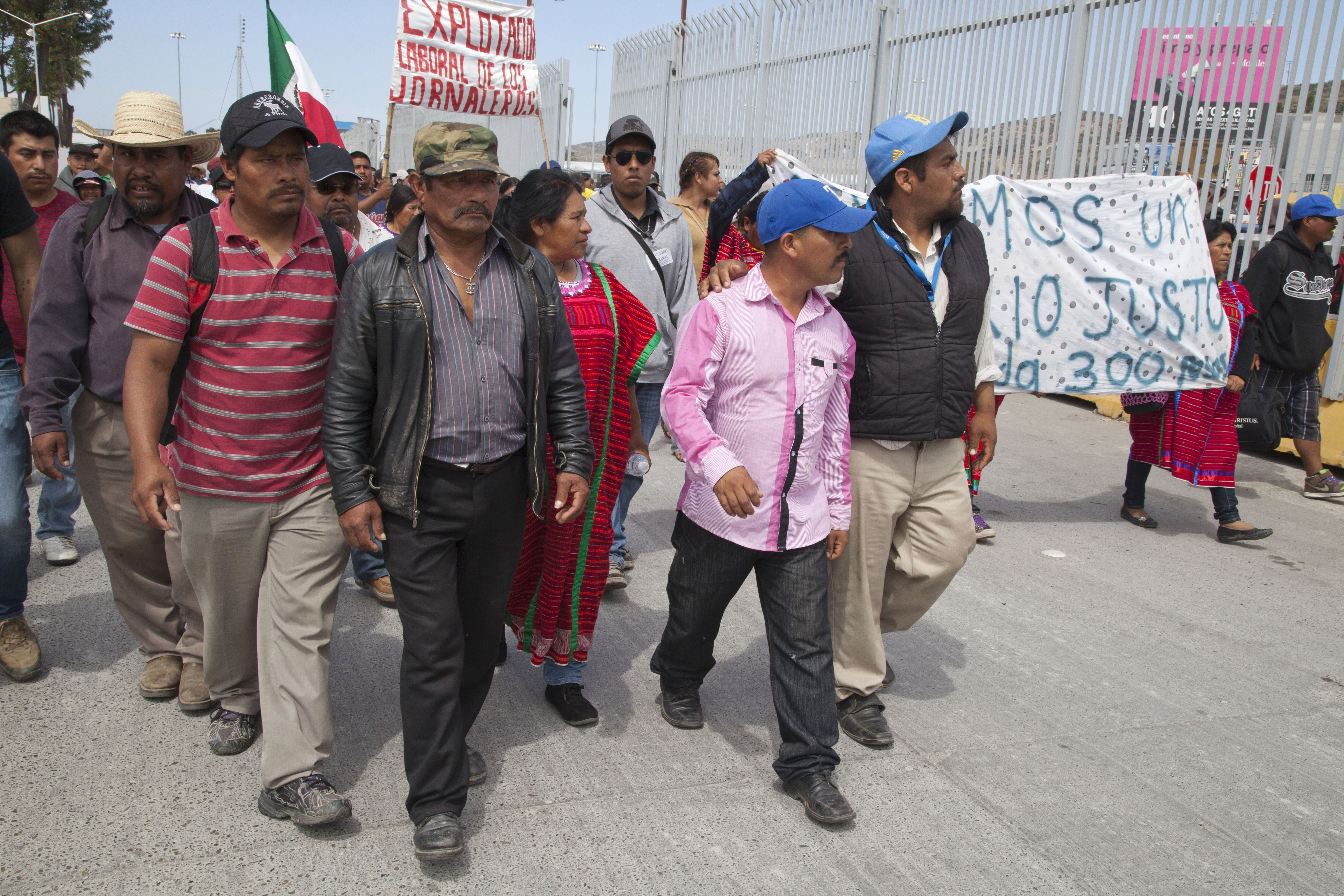by David Bacon
A burned-out concrete blockhouse – the former police station – squats on one side of the only divided street in Vicente Guerrero, half a mile from Baja California’s transpeninsular highway. Just across the street lies the barrio of Nuevo (New) San Juan Copala, one of the first settlements of migrant farm workers here in the San Quintin Valley, named after their hometown in Oaxaca.
Behind the charred stationhouse another road leads into the desert, to a newer barrio, Lomas de San Ramon. Here, on May 9, the cops descended in force, allegedly because a group of strikers were blocking a gate at a local farm. A brutal branch of the Mexican police did more than lift the blockade, though. Shooting rubber bullets at people fleeing down the dirt streets, they stormed into homes and beat residents.
By then a farm labor strike here was already two months old. Some leaders say provocateurs threw rocks and egged on a confrontation, but the beatings undeniably set off smoldering rage in the Lomas and Copala barrios. In addition, a government official who’d agreed to negotiate had failed to show up to talk with strike leaders.
By the end of the day, the police headquarters was a burned-out shell. One of the armored pickup trucks (called “tiburones,” or sharks) driven by police at breakneck speed down the dusty alleyways had been torched as well. It would be hard to imagine a more dramatic demonstration of workers’ fury over four decades of hunger wages.
And while the most dramatic protest this year has taken place in Baja California, the same anger is building among indigenous farm workers all along the Pacific coast, from San Quintin in Mexico to Burlington, an hour south of the U.S. border with Canada. Two years ago Triqui and Mixtec workers struck strawberry fields in Skagit County in Washington State. Two years before that, Triqui workers picking peas in the Salinas Valley rebelled against an inhuman work quota, and immigration raids in the town of Greenfield.
The strawberries, blackberries and blueberries sold everyday in U.S. supermarkets are largely picked by these indigenous families. Their communities are very closely connected, all along the agricultural valleys that line the Pacific Coast. These migrants come from the same region of southern Mexico, often from the same towns. They speak the same languages – ones that were thousands of years old when Europeans first landed on this continent. Increasingly they talk back and forth across the border, sharing tactics and developing a common strategy.
Indigenous farm workers labor for a small number of large growers and distributors who dominate the market. One of the largest distributors is Driscoll’s. Miles Reiter, retired CEO and grandson of its founder, says its intention is “to become the world’s berry company.” Driscoll’s contracts with growers in five countries, and even exports berries from Mexico to China.
Driscoll’s and its Baja partners BerryMex and MoraMex have a large share of Mexico’s berry harvest, worth $550 million annually. Last year Mexico shipped 25 million flats of strawberries to the U.S. Mexican shipments of 16 million flats of raspberries and 22 million flats of blackberries were larger than U.S. domestic production. The company, with headquarters in Watsonville, California, is a partner with growers all along the U.S. Pacific Coast as well.
Global distributors and growers wield enormous economic and political power. But farm workers are beginning to challenge them, organizing independent and militant movements on both sides of the border.
One of the San Quintin strikers, Claudia Reyes (her name has been changed to protect her identity), walked out when the movement started. She works in the huge tomato greenhouses of Rancho Los Pinos, owned by the Rodríguez family, one of the most politically powerful in Baja California. The gulf between her living conditions and the wealth of the grower she works for is typical of indigenous farm worker families in the valley.
Reyes’ home in Santa Maria de Los Pinos is a cinderblock house with a concrete floor, an amenity many neighbors lack. Several years after building it she still can’t come up with the money to buy frames and glass panes for windows. She’s also strung electrical conduit and plugs up the concrete walls, but the government provides no electrical service. “We buy candles for light at night, and I worry that some crazy person might break in and hurt me or the kids, because there are no streetlights either,” she says.
During the six-month work season her family doesn’t go hungry, but they only eat meat twice a week because a kilo costs 140 pesos (about $8). Eggs cost 60 pesos ($4) a carton, she says, “so it takes half a day’s work just to buy one.” She’s paid by the hour, making 900 pesos a week, or 150/day ($9), for the normal 6-day week.
The picking season is only six months long, so workers have to survive during the months when there’s no work. San Quintin’s Mixtec and Triqui laborers originally came as yearly migrants, returning to Oaxaca after picking ended. Today, however, most live in the valley permanently. BerryMex’s labor camp houses 550 temporary migrants, but the rest of its 4-5000 pickers live in the towns along the highway. The Mexican government subsidizes some living costs in the off-season, through an income-based subsidy called IMSS-Oportunidades (recently renamed IMSS-Prospera). But most families have to get what work they can or borrow from friends.
From the editor: Due to lack of space, we weren’t able to print the whole story.



